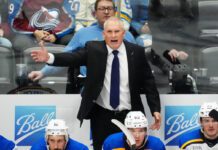On Episode 2 of the MLHS podcast, Ian Tulloch and Anthony Petrielli debated the pros and cons of splitting up the Leafs’ best offensive talent over two power-play groups versus one stacked unit.
Support the MLHS Podcast on Patreon
Early-release full-length video episodes are available to our patrons each week:
Tulloch: I have always been pro-top loading your first power play and playing them for 75-80% of the time. Screw it, leave your best player out there for the entire power play — Ovechkin style. With Auston Matthews, my argument has been that he doesn’t need to be too involved with the entries on the power play. That is kind of a waste of his energy. Just let him set up and do what he does best in the offensive zone.
I always thought that you need to give your best players as much time as humanly possible on the power play. The way to do that is by top-loading it. The Leafs have two effective units this year, but will that still be the case with Wayne Simmonds injured? I don’t think he was the secret sauce on a Matthews and Marner unit — they are the ones driving it — but it is worth noting that Wayne Simmonds led the NHL in rebound chances, inner-slot chances, and deflections in front.
Petrielli: He is an elite net-front guy.
Tulloch: He is good at what he does. If you have guys who can get pucks into the dangerous areas — which, by the way, is the hard part of creating offense in the NHL — then having a guy in front of the net who can deflect and win those battles afterward might have a lot more value than we are realizing. I would be curious if those high-danger chances, the deflection chances, the rebound chances go down significantly in the next six weeks with Simmonds out.
Petrielli: In the game the other night versus Vancouver, Nylander didn’t even play two minutes on the power play. Kerfoot played over five. That is fine against Vancouver. You are going to get away with it against Ottawa, probably Edmonton, probably Calgary.
But if you are looking at a playoff series, after a few games the Leafs are tied or down after a few games, and Nylander is at two minutes a night and Kerfoot is over five, that is not going to go over well.
Tulloch: We have seen them go to it, though. In high-leverage situations, we have seen them go to their four best forwards and Morgan Rielly.
Petrielli: As they should. I do think they will slowly get to the point where they move away from it and really stack up the unit, but they are kind of setting themselves up right now to a point where they would get to the playoffs and not play this the way they are now. I don’t think they could justify the ice-time allocation the way it is currently being divvied up.
Wayne Simmonds is an elite net-front guy. I don’t think his stride is there very much. I don’t think he is particularly effective at five-on-five. But he is a great power-play player. He brings a lot of intangibles, so to speak.
If you are actually asking, “Who are our best five on the power play,” you are putting Wayne Simmonds in front of the net. You are putting Matthews and Marner on the halfwall, and you are putting John Tavares in the bumper role. He has looked good there and has been effective there for years. And you are putting Morgan Rielly up top.
That leaves William Nylander off of the top unit. I don’t know if they want to do that.
Tulloch: I think in a high-leverage situation, you are throwing Nylander out there and they are finding ways to get each other open. A lot of the time, Nylander will go below the goal line and make a pass from behind the net. That is where he is at his best.
Petrielli: I think so, but I think if they are looking at it and being honest, they are probably thinking, “These are the five we are putting out.” But are they doing that to William Nylander?
When Keefe got hired, one of the first things he did — and made a serious point of — was put Nylander with the rest of the guys on the top power-play unit. They didn’t want him to feel excluded and wanted to put the responsibility on him and make him feel a part of the core group. And rightfully so — he is really good, and he makes $7 million a year. He should be part of that group.
Part of it is that they want to split it up so that nobody is feeling like they are lost in the shuffle. Ultimately, I think they are going to have to transition to more of, “Here is our top-line unit,” be it Simmonds or Nylander. That is really how it is going to work.
I think they also know they don’t really have a line that they could put out there after that unit is on for five-on-five. I guess it would be Mikheyev, Kerfoot, and Hyman.
Tulloch: Mike Babcock used to freak out about this. Realistically, for two minutes, you just played your eight most skilled forwards and your two most skilled defensemen. The forwards who have legs for the next shift are going to be your three least skilled forwards and two defensemen who are probably not the greatest puck movers. It is just what happens. It is the nature of a post power-play shift.
The nature of a post-penalty kill shift is that you are going to have your best players available. I think that is the nature of what happens right after a power play and coaches tend to freak out about it. Maybe that’s just me.
Petrielli: I think there is some fairness to it, though. If you don’t score on a power play — and realistically, you don’t score 75+% of the time, unless you are on an absolute heater the way the Leafs are right now — at least you want to build some momentum and kind of tilt the ice into their zone.
If the next thing you’re doing is putting out a line that is going to be run over by the other team’s top line, you’ve kind of lost all of that. In the flow of the game and what is happening, the other team killed it off and they feel good about themselves.
I get it as a fear, especially if you are playing against top forwards you are really worried about.





























![New Leaf Anthony Stolarz on the opportunity in Toronto: “In Florida, I knew my role as a backup… Now, [Joseph Woll] and I are competing for starts… As a goalie, that’s all you can ask for” Anthony Stolarz, Stanley Cup win, now Maple Leaf](https://mapleleafshotstove.com/wp-content/uploads/2024/07/anthony-stolarz-sc-100x70.jpg)
